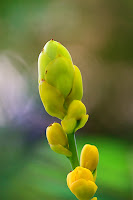

 One of my favourite trees at the Singapore Botanic Gardens is the Monkey Pot tree or Lecythis sapucaia. I like the ones found there as they have a very impressive and very symmetrical umbrella shaped canopy. The other reason why I like this tree is the large fruits it produces. When these fruits, which are also referred to as "pots" fall, they make great decorative pieces for the home. Here is an informative write-up put up by Anthromes on his blog:-
One of my favourite trees at the Singapore Botanic Gardens is the Monkey Pot tree or Lecythis sapucaia. I like the ones found there as they have a very impressive and very symmetrical umbrella shaped canopy. The other reason why I like this tree is the large fruits it produces. When these fruits, which are also referred to as "pots" fall, they make great decorative pieces for the home. Here is an informative write-up put up by Anthromes on his blog:-"Monkey Pot, or Olla del Mono, is a term to describe not only L. zabucajo, but a number of other closely related species, including: Lecythis elliptica, Lecythis grandiflora, and Lecythis pisonis.
All of the Monkey Pot species are native to the humid tropical forests of northern South America, from Colombia to Brazil. They have been introduced on a small scale to a number of countries with similar climates around the world.
The trees are of varying sizes. Lecythis elliptica is smaller with spreading branches, the others can reach heights of over 35 meters, also with a spreading canopy, also about 35 meters, if not more.
There are a few old L. zabucajo trees in a stand where I collected seed, remarkably wide canopy, close to sixty feet I would say. The branches arc up and out until they almost touch the ground. Typically, one can locate an open pod and merely walk around beneath it and find seed. However, the agouti forage for nuts in these trees and will chew through the woody pod to extract them. So I had to climb up the end of a branch and hang precariously while pulling on a rope tied around a higher branch holding the fruit, then clip the 3/4 inch stem.
 The fruit is a roundish and woody with a cap that pops off when it’s reached maturity. Inside are anywhere from 8 – 40 seeds (depending on the species) which fall from the woody capsule after a period of time.
The fruit is a roundish and woody with a cap that pops off when it’s reached maturity. Inside are anywhere from 8 – 40 seeds (depending on the species) which fall from the woody capsule after a period of time.Although they are little known outside their area of origin, the nuts produced by these species are among the best in the world, equal or superior in flavor to the Brazil Nut. There is a cream colored arial attached to the end of each seed. On numerous occasions I have tried it, it has a sweet licorice-like flavor although I was once told it has psychoactive properties. The tree wood is also of high quality.
The Monkey Pot species require a hot, humid climate. Deep, well drained soils are preferable. The young trees will also benefit from a shady environment in their first few years of growth.
Propagated by seeds, which will germinate in anywhere from 2 weeks to 4 months. In my experience, fresher seed will germinate faster. Initial growth is fast, a young tree can reach a meter in height in its first year. Trees are typically spaced 8 – 10 meters apart in plantations."
So far, I have managed to obtain 8 pots and have even attempted to propagate the seeds.
















































